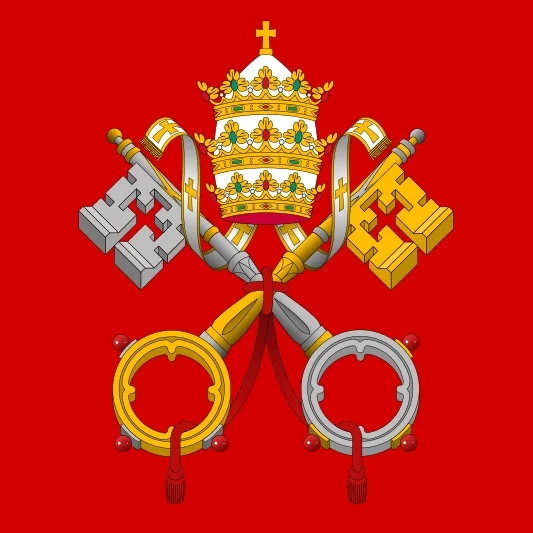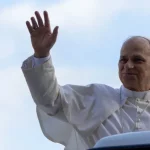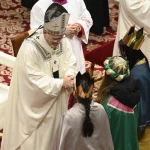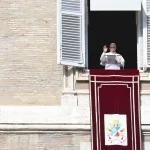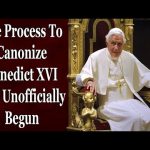
The Blessed Virgin Mary
Feast Days:
January 1th Solemnity of Mary, Mother of God
March 25th – Annunciation
May 31st – Visitation
August 15th – Assumption
August 22nd – Queenship of Mary
September 8th – Birth of Mary
September 12th The Most Holy Name of Mary
November 21th – Presentation of the Blessed Virgin Mary
December 8th – Immaculate Conception
The Blessed Virgin Mary Mother of God is the greatest of all Saints. The Virgin Mother “was, after her Son, exalted by divine grace above all angels and men.” The main events of her life are celebrated as liturgical feasts of the universal Church. Mary’s life and role in the history of salvation is foreshadowed in the Old Testament, while the events of her life are recorded in the New Testament. Traditionally, she was declared the daughter of Sts. Joachim and Anne. Born in Jerusalem, Mary was presented in the Temple and took a vow of virginity. Living in Nazareth, Mary was visited by the archangel Gabriel, who announced to her that she would become the Mother of Jesus, by the Holy Spirit. She became betrothed to St. Joseph and went to visit her cousin, St. Elizabeth, who was bearing St. John the Baptist. Acknowledged by Elizabeth as the Mother of God, Mary intoned the Magnificat. When Emperor Augustus declared a census throughout the vast Roman Empire, Mary and St. Joseph went to Bethlehem, his city of lineage, as he belonged to the House of David. There Mary gave birth to Jesus and was visited by the Three Kings. Mary and Joseph presented Jesus in the Temple, where St. Simeon rejoiced and Mary received word of sorrows to come later. Warned to flee, St. Joseph and Mary went to Egypt to escape the wrath of King Herod. They remained in Egypt until King Herod died and then returned to Nazareth. Nothing is known of Mary’s life during the next years except for a visit to the Temple of Jerusalem, at which time Mary and Joseph sought the young Jesus, who was in the Temple with the learned elders. The first recorded miracle of Jesus was performed at a wedding in Cana, and Mary was instrumental in calling Christ’s attention to the need. Mary was present at the Crucifixion in Jerusalem, and there she was given into John the Apostle’s care. She was also with the disciples in the days before the Pentecost, and it is believed that she was present at the resurrection and Ascension. No scriptural reference concerns Mary’s last years on earth. According to tradition, she went to Ephesus, where she experienced her “dormition.” Another tradition states that she remained in Jerusalem. The belief that Mary’s body was assumed into heaven is one of the oldest traditions of the Catholic Church. St. Paul observed that “God sent His Son, born of a woman,” expressing the union of the human and the divine in Christ. As Christ possesses two natures, human and divine, Mary was the Mother of God in his human nature. This special role of Mary in salvation history is clearly shown in the Gospel where she is seen constantly at her son’s side during his soteriological mission. Because of this role, exemplified by her acceptance of Christ into her womb, her offering of him to God at the Temple, her urging him to perform his first miracle, and her standing at the foot of the Cross at Calvary Mary was joined fully in the sacrifice by Christ of himself. Mary possesses a unique relationship with all three Persons of the Trinity, thereby giving her a claim to the title of Queenship. She was chosen by God the Father to be the Mother of his Son; God the Holy Spirit chose her to be his virginal spouse for the Incarnation of the Son; and God the Son chose her to be his mother, the means of incarnating into the world for the purposes of the redemption of humanity. This Queen is also our Mother. While she is not our Mother in the physical sense, she is called a spiritual mother, for she conceives, gives birth, and nurtures the spiritual lives of grace for each person. As Mediatrix of All Graces, she is ever present at the side of each person, giving nourishment and hope, from the moment of spiritual birth at Baptism to the moment of death.

St. Joseph
Feast Days:
March 19th -The Solemnity of St. Joseph
May 1st – The Feast of St. Joseph the Worker
St. Joseph was a carpenter, a working man, for the skeptical Nazarenes ask about Jesus, “Is this not the carpenter’s son?” (Matthew 13:55). He wasn’t rich for when he took Jesus to the Temple to be circumcised and Mary to be purified he offered the sacrifice of two turtledoves or a pair of pigeons, allowed only for those who could not afford a lamb (Luke 2:24). Despite his humble work and means, Joseph came from a royal lineage. Luke and Matthew disagree some about the details of Joseph’s genealogy but they both mark his descent from David, the greatest king of Israel (Matthew 1:1-16 and Luke 3:23-38). Indeed the angel who first tells Joseph about Jesus greets him as “son of David,” a royal title used also for Jesus. Joseph was a compassionate, caring man. When he discovered Mary was pregnant after they had been betrothed, he knew the child was not his but was as yet unaware that she was carrying the Son of God. He knew women accused of adultery could be stoned to death, so he resolved to send her away quietly to not expose her to shame or cruelty. However, when an angel came to Joseph in a dream and told him, 20 “Joseph son of David, do not be afraid to take Mary home as your wife, because what is conceived in her is from the Holy Spirit. 21 She will give birth to a son, and you are to give him the name Jesus, because he will save his people from their sins,” he did as the angel told him and took Mary as his wife. (Matthew 1:19-25).When the angel came again to tell him that his family was in danger, he immediately left everything he owned, all his family and friends, and fled to a strange country with his young wife and the baby. He waited in Egypt without question until the angel told him it was safe to go back (Matthew 2:13-23). Joseph loved Jesus. His one concern was for the safety of this child entrusted to him. Not only did he leave his home to protect Jesus, but upon his return settled in the obscure town of Nazareth out of fear for his life. When Jesus stayed in the Temple we are told Joseph (along with Mary) searched with great anxiety for three days for him (Luke 2:48). We also know that Joseph treated Jesus as his own son for over and over the people of Nazareth say of Jesus, “Is this not the son of Joseph?” (Luke 4:22). Joseph respected God. He followed God’s commands in handling the situation with Mary and going to Jerusalem to have Jesus circumcised and Mary purified after Jesus’ birth. We are told that he took his family to Jerusalem every year for Passover, something that could not have been easy for a working man. Since Joseph does not appear in Jesus’ public life, at his death, or resurrection, its is believed that Joseph probably died before Jesus entered public ministry.

St. Michael the Archangel
Feast Day: September 29th
St. Michael led the Heavenly forces against Satan and his fallen angels. He continues to wage this war for our souls today. Tradition also holds that he is to escort those who are going to Heaven at their moment of death. He is a champion and protector of all Christians from dangers and perils. He has appeared in a cave in Gargano four times. A basilica was built on the site of these apparitions in his honor. It was through his intercessions that many were spared of a plague spreading rapidly at that time in Europe. Rocks from Gargano are considered to be his relics. There are also many legends of him protecting Christians from both physical and spiritual dangers. His role as general and commander of the forces of Jesus against Satan and all evil works is crucial to the exorcism ministry.

Saint Elias (Elijah) The Prophet
Feast Day: July 20th
Saint Elias (also known as Saint Elijah) was a mighty and faithful prophet of the Old Testament during the time when Israel turned away from the Lord God to worship the false god Baal. He was sent to show Israel the evil of their ways and return them to the Lord by challenging the prophets of Baal to a contest on Mount Carmel. Saint Elias told them that if they prepared a sacrifice and called on Baal, he would prepare a sacrifice and call on the Lord, whichever caught fire would demonstrate who was the true God. The prophets of Baal prepared their sacrifice and prayed from morning until noon, with no answer, while Saint Elias mocked them. Then he rebuilt the altar of the Lord, prepared the sacrifice, and poured four jugs of water on it. He called upon the God who sent fire from heaven engulfing the sacrifice and everything around it. Seeing this the people fell on their faces and once again professed their faith in the one true God of Israel.

St. John The Baptist
Feast Days:
Birth – June 24th
Martyrdom – August 29th
Cousin of Jesus Christ. Son of Zachary, a priest of the order of Abia; and of Elizabeth, a descendent of Aaron. An angel brought Zachary news that Elizabeth would bear a child filledwith the Holy Spirit from the moment of his birth. Zachary doubted and was struck dumb until John’s birth. Prophet. Began his ministry around age 27, wearing a leather belt and a tunic of camel hair, living off locusts and wild honey, and preaching a message of repentance to the people of Jerusalem. He converted many, and prepared the way for the coming of Jesus. Baptized Christ, after which he stepped away and told his disciples to follow Jesus. Imprisoned by King Herod and beheaded by him.

St. Mary Magdalene
Feast Day July 22nd
Friend and follower of Jesus, who upon meeting The Lord, was exorcized her of seven demons and it is likely that she was a terrible sinner before meeting Christ. This changed her life forever and she began to follow Him. She is sometimes referred to as the ‘Apostle to the Apostles’ because she was the person chosen by God to announce to the apostles the mystery of the Resurrection of Jesus.

St. Jude the Apostle
Feast Day: October 28th
Son of Cleophas, who died a martyr, and Mary who stood at the foot of the Cross, and who anointed Christ’s body after death. Brother of St. Lesser. Nephew of Mary and Joseph; blood relative of Jesus Christ, and is reported to look a lot like him. May have been a fisherman. Writer of a New Testament letter. Preached in Syria, Mesopotamia, and Persia with St. Simon. Healer. Exorcist (exorcised pagan idols, which caused the demons to flee and their statues to crumble). Martyr.

St. Catherine of Siena
Feast Day: April 29th
She was the Youngest child in a large family and At the age of 6 she had a vision in which Jesus appeared and blessed her. Her parents wanted her to marry, but she became a Dominican tertiary. Mystic. Stigmatist. Received a vision in which she was in a mystical marriage with Christ, and the Infant Christ presented her with a wedding ring. Counselor to Pope Gregory XI and Pope Urban VI. Proclaimed Doctor of the Church on 4 October 1970.

St. Patrick
Feast Day: March 17th
Kidnapped from the British mainland around age 16, and shipped to Ireland as a slave. Sent to the mountains as a shepherd, he spent his time in prayer. After six years of this life, he had a dream in which he was commanded to return to Britain; seeing it as a sign, he escaped. He studied in several monasteries in Europe. Priest. Bishop. Sent by Pope St. Celestine to evangelize England, then Ireland, during which his chariot driver was St. Odran. St. Jarlath was one of his spiritual students. In 33 years he effectively converted Ireland. In the Middle Ages Ireland became known as the Land of Saints, and during the Dark Ages its monasteries were the great repositories of learning in Europe, all a consequence of Patrick’s ministry.

Saint George
Feast Day: April 23rd
Born to a devout Christian family that was wealthy and of noble origin of the Eastern Roman Empire, in Asia Minor. George joined the Roman army where his ability and devotion brought him quick accolades and rank. St. George travelled with Constantine to Britain and visited holy places and upon on his return he was met with a fierce storm of persecution. Emperor Diocletian issued a edict against all Christians stating: “All churches should be levelled to the ground. All sacred books to be burned. All Christians who hold any honorable rank are not only to be degraded, but to be deprived of civil rights. Also, All Christians who are not officials are to be reduced to slavery”. With great courage George, deliberately tore down the Imperial edict and threw it away. Consequently, he was arrested and brought to the presence of emperor who he rebuked for persecuting. Christians. After George was not swayed with promises of power he was then cast into the dungeon and tortured for confessing the Lord Jesus Christ.

St. Anthony of Padua
Feast Day: June 13th
When the remains of St. Berard and his companions, the first Franciscan martyrs, were brought to be buried in his church, Anthony was moved to leave his order and enter the Friars Minor (Franciscans). One day when a scheduled speaker failed to appear, the brothers pressed him into speaking. He so impressed them that he was thereafter constantly traveling, evangelizing, preaching, and teaching theology through Italy and France. A gifted speaker, he attracted crowds everywhere he went, speaking in multiple tongues; legend says that even the fish loved to listen. Wonder worker. One of the most beloved of saints.

St. Dominic
Feast Day: August 8th
St. Dominic was born in Caleruega Spain in 1170. He was born to a noble family. His mother, Bl. Joan of Aza, was also a very holy woman. St. Dominic is remembered for being given the Holy Rosary in 1214 by the Blessed Mother herself. This devotion was not seen much before then. He founded the Order of Preachers as well (Dominicans). He is also well known to have fought the Albigensian heresy which taught that all matter is evil. He was also a man of intense discipline and mortifications, not even owning a bed. A famous painting by Pietro della Vecchia entitled St. Dominic and the Monkey encapsulates one story about St. Dominic. Satan often harassed St. Dominic. One night Satan appeared as a monkey in Dominic’s library attempting to distract him from study by throwing books off shelves and trying to spill ink on Dominic’s writing. Eventually Dominic had enough and commanded Satan to hold to the candle for him while he wrote. Through the power of Jesus, Satan was compelled to obey. St. Dominic often overcame the devil which is why his intercession is powerful in casting evil out.

St. Charbel Makhlouf The Hermit
Feast Day July 24th
Youssef Antoun Makhlouf Son of a mule driver was born in Bekaa Kafra Northern Lebanon and He was raised in the faith with two uncles that were both hermits and as achild had an intense love of prayer. At age 23 he snuck away to join the Baladite monastery of Saint Maron at Annaya where he took the name Charbel in memory of a 2nd century martyr and professed his solemn vows in 1853, the was ordained in 1859, becoming a priest. He lived as a model monk, but dreamed of living like the ancient desert fathers. As a hermit from 1875 until his death 23 years later, living on the bare minimums of everything. Gained a reputation for holiness, and was much sought for counsel and blessing. He had a great personal devotion to the Blessed Sacrament, and was known to levitate during his prayers. Briefly paralyzed for unknown reasons just before his death. When he died on Christmas Eve 1898, lights were seen around his grave and his body secreted sweat and blood. Several post-mortem miracles attributed him, including periods in 1927 and 1950 when a bloody “sweat” flowed from his corpse. His tomb has become a place of pilgrimage for Lebanese and non-Lebanese, Christian and non-Christian alike and his miracles have brought many back to the faith.

St. Gemma Galgani
Feast Day: April 11th
Gemma desired to be a nun but her poor health prevented this. She fell ill at one time with meningitis and through the intercession of St. Gabriel Possenti, was healed. The most notable feature of her life was her mysticism. She had apparitions of St. Gabriel Possenti, she could speak directly to Jesus, she went into many ecstasies, and she was also given the grace of the stigmata. Physicians would try and surprise her to study her stigmata, but when they would come, it would go away. Under the obedience of her confessor she was compelled to write an autobiography. Her clear love of Jesus made her especially hated by Satan who would regularly try to attack her. She was known to spit at, mock, and ignore Satan even during his strongest attacks (which she was later strictly forbidden from doing by her spiritual director).

St. Pope Pius X
Feast Day: August 21st
Son of a village cobbler, he lived an impoverished childhood as one of eight children. Felt a calling to the priesthood from his youth. Chosen as the 257th pope, taking the name Pius X. Issued a decree reducing the age for reception of First Communion from age 12 to 7. Destroyed the last vestiges of Jansenism by advocating frequent and even daily Communion. Reformed the liturgy, promoted clear and simple homilies, and brought Gregorian chant back to services. Revised the Breviary, and teaching of the Catechism. Reorganized the Roman curia, the administrative elements of the Church. Worked against the modern antagonism of the state against the Church. Initiated the codification of Canon Law. Promoting Bible reading by all the faithful. Supported foreign missions. His Last Will and Testament read: “I was born poor; I lived poor; I wish to die poor.”

St. Padre Pio of Pietrelcina
Feast Day: September 23rd
As a child he was very holy. He was known to be able to see guardian angels as well as speak to Mary and Jesus. His remarkable holiness was also met with remarkable suffering. Francesco was often ill and his family was poor. He was not able to study much between his bad health and needing to help his family. Eventually his family sacrificed a lot to allow him to go into the Capuchin Friars. Padre Pio is still to this day well known for his incredible gift of healing and the stigmata among many other miracles such as bilocation, reading of hearts, and casting out devils. Satan would harass Padre Pio often, coming into his cell at night both tempting and beating him. Through all of these attacks Padre Pio remained faithful and at peace following Christ.

St. Maximilian Kolbe
Feast Day: August 14th
Ordained Franciscan priest. Devoted to the Blessed Virgin. Founded a prolific Catholic magazine in Poland which at its peak it had a press run of 750,000 copies a month. Spread this ministry to Japan and India. Upon return to Poland was arrested by the Nazis for his publications. Sent to Auschwitz death camp; branded as prisoner 16670. Received more beatings at Auschwitz than other prisoner. At one point he was beaten, lashed, and left for dead. The prisoners managed to smuggle him into the camp hospital where he spent his recovery time hearing confessions. When he returned to the camp, Maximilian ministered to other prisoners, including conducting Mass and delivering communion using smuggled bread and wine. Volunteered to take the place of another prisoner sentenced to death place, and died as he had always wished, in service of God and others.
